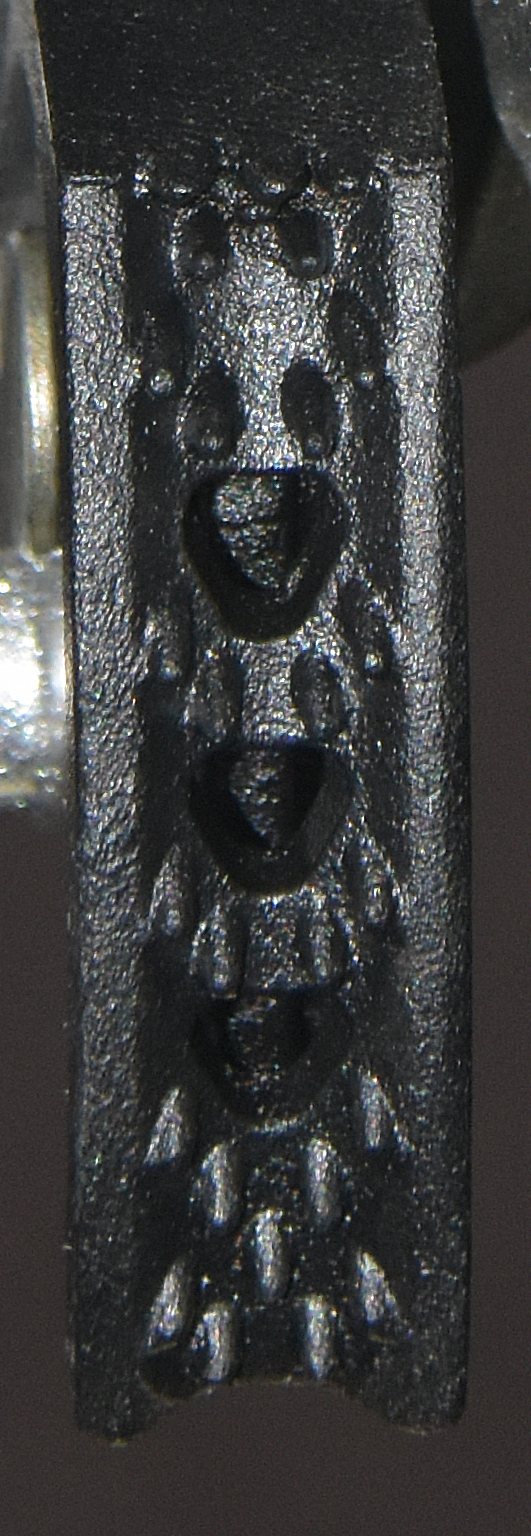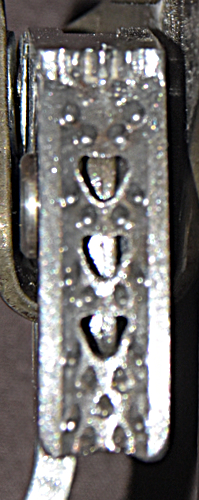Overview
[ Top
| Krol
| Return to E.C. Ascenders
]
Chest Strap
(#1582)
Technical Details
I acquired my Krok Chest Ascender from Gear4Rocks in 2012.
 The Krok Chest Ascender is 114 mm. tall, 69 mm. wide, 31 mm. thick, and weighs 147 g.
The ascender is left-handed, as are virtually all chest ascenders
that I have seen. The ascender
shell is subtriangular shape bent from 3.8 mm. aluminum
sheet. The rope channel is formed by bending the right side of
the ascender into a squared-off U. The rope channel is 15.2 mm. wide.
The main sling attachment point is a 19.2 mm. hole located below the cam and behind
the rope channel. The lower left side of the hole is bent backward to allow a carabiner to rotate parallel to one’s chest. A second attachment point lies above the cam,
also behind the rope channel. The left end of the shell is
bent on an inclined axis to form another U. A hole drilled through
both sides of the U accepts a steel rivet. The cam and cam spring
are mounted on this rivet. The
pivot is centered 32 mm. from the inside of the rope channel. There is a cylindrical cam stop above the cam.
The Krok Chest Ascender is 114 mm. tall, 69 mm. wide, 31 mm. thick, and weighs 147 g.
The ascender is left-handed, as are virtually all chest ascenders
that I have seen. The ascender
shell is subtriangular shape bent from 3.8 mm. aluminum
sheet. The rope channel is formed by bending the right side of
the ascender into a squared-off U. The rope channel is 15.2 mm. wide.
The main sling attachment point is a 19.2 mm. hole located below the cam and behind
the rope channel. The lower left side of the hole is bent backward to allow a carabiner to rotate parallel to one’s chest. A second attachment point lies above the cam,
also behind the rope channel. The left end of the shell is
bent on an inclined axis to form another U. A hole drilled through
both sides of the U accepts a steel rivet. The cam and cam spring
are mounted on this rivet. The
pivot is centered 32 mm. from the inside of the rope channel. There is a cylindrical cam stop above the cam.
The cam is a skeletonized steel casting. The cam radius,
measured from the pivot, increases from 37 to 58 mm. over an angle of 41°, giving a 32° cam angle.
The tooth pattern is (3.2)(2.2.H)^3(2.2.3.2). A spring-loaded manual safety
bar pivots on an axle riveted to the cam. The normal action of
the spring holds the safety against the cam. When the cam is opened,
the shell interferes with the safety bar, thus preventing opening
the cam. If the safety bar is moved away from the cam (opposing
the spring), it will clear the shell and the cam will open. At
full open the safety can be released and the spring will hold
the safety against the back of the shell. This provides a means
of locking the cam open. Two pins on the safety assist in operating
the safety mechanism.
The front of the rope channel is stamped with the Krok logo, a book-with-an-"i" icon, and "06 11."
The cam safety is both awkward an unique. Opening the ascender
one-handed is rather difficult. When the cam hold-open is active,
releasing the cam is easy; a light tap will cause the spring to pull the cam closed.
The workmanship and finish on the Krok are adequate but inferior to many Western ascenders. Gear4Rocks advertises their equipment as "functional, serviceable, affordable & safe, not pretty or trendy." The ascender design has been tested by "STANDART," the Ukrainian National Scientific-Certification Center in Kiev, the capital of Ukraine. Testing procedures are based on CE and UIAA standards.
[ Top
| Chest Strap
| Return to E.C. Ascenders
]
Krol
(Кроль)
(3603_1445.25/1)
(#1582)
Technical Details
I acquired my Krok Krol 3603_1445.25/1 (Кроль) from Krok in 2021.
 The Krok Krol is 109 mm. tall, 72 mm. wide, 30 mm. thick, and weighs 217 g.
The Krok Krol is 109 mm. tall, 72 mm. wide, 30 mm. thick, and weighs 217 g.
The Krok Chest Ascender is 114 mm. tall, 69 mm. wide, 31 mm. thick, and weighs 147 g.
The ascender is left-handed, as are virtually all chest ascenders
that I have seen. The ascender
shell is subtriangular shape bent from 2.3 mm. steel
sheet and then painted. The rope channel is formed by bending the right side of
the ascender into a U. The rope channel is 17 mm. wide.
The main sling attachment point is a 20 m. hole located below the cam and behind
the rope channel. The lower left side of the hole is bent backward to allow a carabiner to rotate parallel to one’s chest. A second attachment point lies above the cam. This is a 27 mm. wide, 8 mm. high slot with a semicircular cutout in the bottom to allow hanging the Krol on a a carabiner. The left end of the shell is
bent on an inclined axis to form another U. A hole drilled through
both sides of the U accepts a steel rivet. The cam and cam spring
are mounted on this rivet. The
pivot is centered 49 mm. from the inside of the rope channel. There is a cylindrical cam stop above the cam.
The cam is a painted skeletonized steel casting. The cam radius increases from 37 to 58 mm. over an angle of 42°, giving a 31° cam angle. The tooth pattern is (3.2.2)(1H1.2)^3(2.3.2). A spring-loaded manual safety
bar pivots on an axle riveted to the cam. The normal action of
the spring holds the safety against the cam. When the cam is opened,
the shell interferes with the safety bar, thus preventing opening
the cam. If the safety bar is moved away from the cam (opposing
the spring), it will clear the shell and the cam will open. At
full open the safety can be released and the spring will hold
the safety against the back of the shell. This provides a means
of locking the cam open. Two pins on the safety assist in operating
the safety mechanism.
The front of the rope channel is printed with "WLL 15kN," a hollow up-pointing arrow with "Max 400 кг" inside,"MBS 25kN," the Krok logo, "20.11.20.11," and a book-with-an-"i" icon.
The cam safety is painted with the same paint as the cam, making it rather slippery. The cam spring is quite strong. This combination makes it fairly easy for the safety to slip out of my fingers when I try to open it.
The steel body makes the Krol rather heavy, particularly for a stamped-shell chest ascender.
The workmanship and finish on the Krol are better than on the Chest Strap. The 400 kg. working load limit is based on rope damage, while the working load limit is where body deformation begins. The numbers for the Krol are more than adequate for a frog chest ascender.
[ Top
| Chest Strap
| Krol
]


